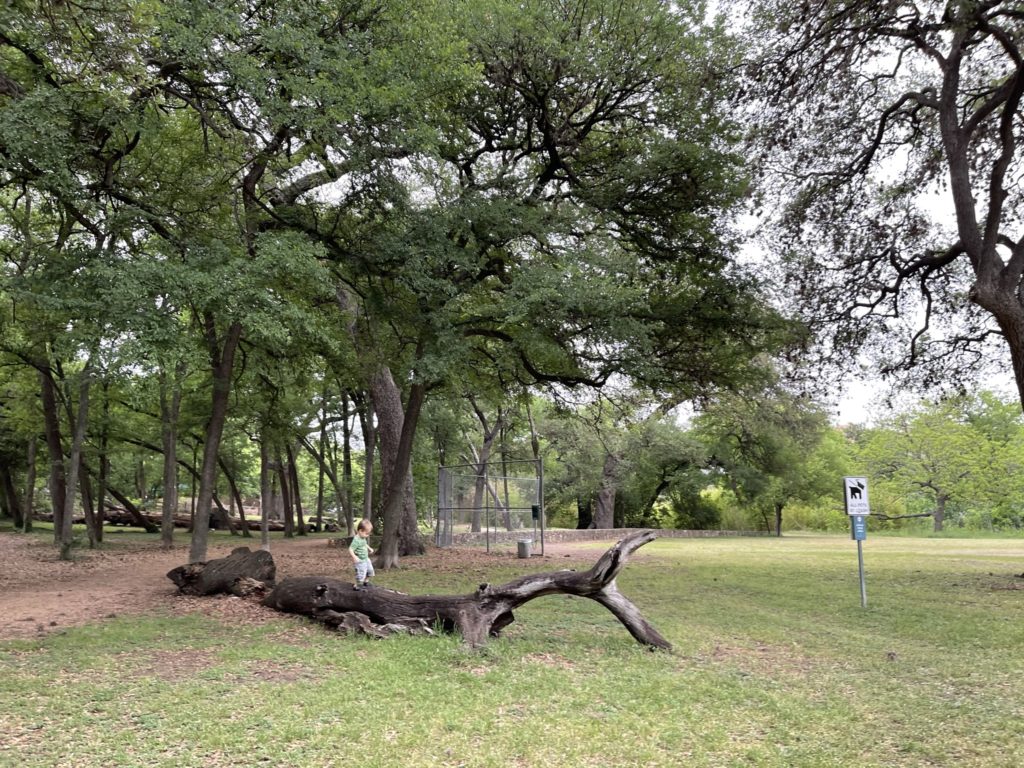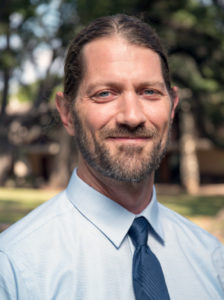By Dr. Anthony Baker
Places Where God Speaks
I believe God speaks uniquely in each space, each little ecosystem, we pass through. Just down Rathervue Place, across Harris Park Avenue, is one of my favorite places in which to hear God speak. Eastwoods Park. I can’t even pass by without a flood of memories. Walks alone, walks with my wife. Explorations with my children. I still see them swinging on vines, looking for tadpoles. One particular tree looked to us like it might start talking and waving its arms at any moment. That’s why my son named it after a Tolkien character: that twisted growth of wood fiber will always be Treebeard to me.
All these memories are, for me, memories of the love that God is revealing to me in this place. I taught one of my kids to ride her bike here. Another time, during an emotionally overwhelming week, my Aunt Glenda suggested a stomp-walk through the woods. So I walked over to the park and started stomping. Soon that didn’t feel adequate, so I started throwing rocks down the creek. I did that long enough and with enough force that my arm got sore, and I went back and texted Aunt Glenda about it. The next day when I called my grandparents, Grandpa answered the phone by saying, “How’s your arm?” And then he let fly with his cackle of a laugh.
More Voices
Once the memories start I have trouble stopping them. One day my daughter and I met middle-aged siblings who had grown up across Sparks Avenue, in the home of their law professor father. He spent well over half a century walking the park, they said. Now they’d all regathered in the family house to say goodbye. They stood on the bridge, watching us hunt for life in the creek below, and told us about catching frogs and having arguments in the very spot we were in, 60 years ago. Love, grief, and more love.
The park is also the home of many Seminary memories. An epic kickball game. Countless flag football practices as we prep for our annual showdown with the Presbyterians (Go Thuri-Bulls!).
When I taught a class called “Hope for Creation,” I gave students the assignment of finding “hopeful spaces” on campus and taking us on walks to see them. One student, who couldn’t wait for seminary to be over so he could go back the places he held affection for, took us on a field trip into Eastwoods. He walked us to one of the grander, older trees, standing erect at the edge of the park. “This tree has been here for a very long time,” he said. “And if it can last 100 years here, I can make it another few months.” That’s a hopeful space, as far as I’m concerned. He got an A on the assignment.
Eastwoods is famous in Austin for being the place that U.T.’s beloved Shakespeare professor Doc Ayres and his friends first started Eeyore’s Birthday Party back in the 60s. Soon after I started walking the park, the city put up a statue of the world’s most famous melancholy donkey. They didn’t bolt it down at first though, and for a year or two it became a favorite frat prank around UT to steal Eeyore. That sounds like the kind of thing my friends and I would have done in college.
I’ve got my memories of the place, and my family shares many of them with me. Those siblings and frat boys have their memories. And so many others, memories and stories I’ll never hear of.
Almost Forgotten Stories
I heard a story about Eastwoods park not long ago, from my former colleague and still friend Dan Joslyn-Siemiatkoski. It was one I’d never heard, despite nearly two decades of affection for the place. He told me that the park was once called Wheeler’s Grove, and it hosted the first public celebrations of Juneteenth in the years after the Emancipation Proclamation. Texas slaves, of course, didn’t get the news of their freedom until Yankee troupes arrived in Galveston on June 19th, 1865. The parties at Wheeler’s started soon after, and by the turn of the century the annual commemoration was a major event with flags, bunting, grandstands, speeches, food, and even a festival queen. The free men and women and children of Austin loved a good celebration. Someone took photos in 1900. I’ve tried, with limited success, to find the park I know in those old black and whites that mark the memories of others.
The postbellum South was a complex place, to say the least. Though there were many powerful forces working against civil liberties for people of color, Reconstruction seemed to make new things possible. The cities of the South built public spaces where Black and white people could pass each other on the streets and say hello. White people were welcome at the parties at Wheeler’s Grove.
But by the 1920s, those ugly forces were coming out hiding. The Klan and other less dramatic racists took to the streets and the courthouses. Bankers and progressive Presidents drew red lines around Black neighborhoods, decreeing no one within those lines could receive a federally insured loan. Or, as local man from Austin told me this week on a student-led tour of East Austin, they could get “contract loans,” documents which included a clause stating that one late payment could lead to repossession.
Parks and Palimpsests
Austin’s re-reconstruction was intentional and aggressive. They shut the water off in Black owned homes. They posted signs outlawing Black skin within entire communities. In 1928, they declared Hyde Park and the surrounding area, including Wheeler’s Grove, a whites only establishment. The Juneteenth celebration moved on to another place: “Emancipation Park,” they called their new home. And Wheeler’s Gove became Eastwoods Park.
Textual historians use the Greek word “palimpsest” for a document that has been repurposed. When a monk or scribe needed to write something, sometimes he would find a used piece of parchment that had information on it that he deemed unimportant. So he would erase it as well as he could, and begin making into something new. Inevitable the erased words would leak through, leaving faint traces of the old writing.
Eastwoods Park is a palimpsest. Eeyore’s Statue commemorates the new, post ’29 history of the park. I love that park. It’s been a home to me. So do those siblings who greeted us from the bridge.
But there’s another park there, almost erased, but still showing in the occasional pen stroke or smudged letter. The erased document shows up in photographs, family stories, the archival work of historians like Dan.
The city council back in 1928 was setting out to create a utopia—a word that literally means “no-place.” You make a utopia by erasing—attempting to erase—a place that exists, with its memories and stories and inhabitants, so that you can make a place of your own, without the bother of other people and animals and plants around you. Utopias seek to create a future for a place, and one with no traceable connection to a past.
Doc Ayres, who spent his life teaching children—like my son—to put on Shakespeare plays in a barn, and whom I’m fortunate to call a friend, likely didn’t know this story. Even if he did, I don’t suppose he would have thought it reason to choose another spot to celebrate Eeyore. And now, created as it was by a kind and beloved white professor and community leader, his “document” has proved much easier to celebrate and remember than the one that those earlier white community leaders erased.
Deep and Critical Listening
When I returned from sabbatical this January, I was pleased to see the city has put up a display at the park’s entrance, telling the story of Wheeler’s Grove. Like archivists bending over those erased and reused scrolls, community leaders managed to organize around the long erased history of one of my favorite places.
I want to hear the voice of this park. I want to hear how it speaks itself into being as a place formed by God to bring rest and joy to God’s creatures. I want to hear it speak a divine word in a way no other place on earth can.
But I want to hear the place itself—not just my own voice reminiscing fondly about my days there. The park sang happily those days, I believe. But it’s got more story to tell, and not all of it is pleasant to recall. It remembers scraped knees on gravel. It remembers broken hearted young people walking its paths. It remembers the day I hurt my shoulder throwing rocks. And it remembers the day the freed men and women of Austin were no longer invited to come and celebrate their humanity in the shade of its ash and live oak trees.
What are the places you feel affection for?
What memories might that place hold for others, living or dead?
How might you give voice to some of that divine language?




4 Responses
Tony, thank you.
Thank you for helping to keep Wheeler Grove alive.
Thank you for that flood of memories! And for a new way to see a beloved place. Well done!
Thank you, Tony.